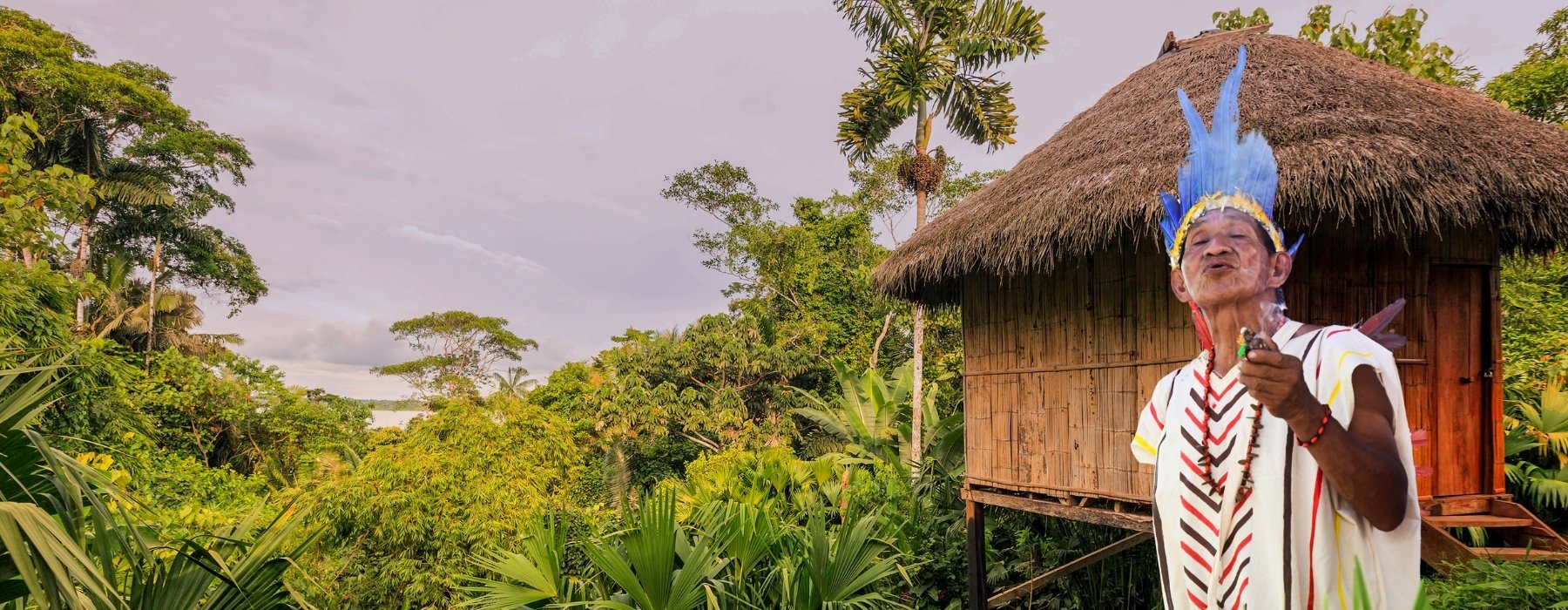
The Amazonian culture of Iquitos is characterized by its rich ethnic diversity and ancestral traditions, which reflect the interaction between indigenous communities and colonizers. This cultural fusion is manifested in music, dance and local festivities, as well as in gastronomy, which incorporates indigenous ingredients and traditional cooking techniques.
The culture of Iquitos is characterized by a rich diversity that reflects the interaction between indigenous communities and external influences over time. This area, located in the heart of the Peruvian Amazon, is home to numerous ethnic groups, such as the Quichuas and the Yaneshas, who preserve ancestral traditions that are manifested in their music, dances and rituals. Each of these dances has its own style, history and cultural meaning. These dances are an important part of the cultural festivities and celebrations in Iquitos, reflecting its rich indigenous and mestizo heritage.
Gastronomy also plays a fundamental role in this culture. Typical dishes such as juane and tacacho con cecina are emblematic examples that use local ingredients and culinary techniques passed down from generation to generation. In addition, regional festivities are often colorful and vibrant, with celebrations that honor both ancestral deities and natural cycles.
Art in Iquitos is expressed through various manifestations, including crafts made with native materials such as plant fibers and wood. These works are not only representative of local talent but also reflect a deep connection with the natural environment. In Iquitos, various crafts are made that reflect the culture and traditions of the Amazon region. Basket making, wood carving, hand-woven fabrics with traditional motifs, using ancestral techniques. Accessories made with seeds, precious stones and organic materials. These crafts are not only commercial products, but also a way to preserve the cultural identity of the indigenous peoples of the Amazon.
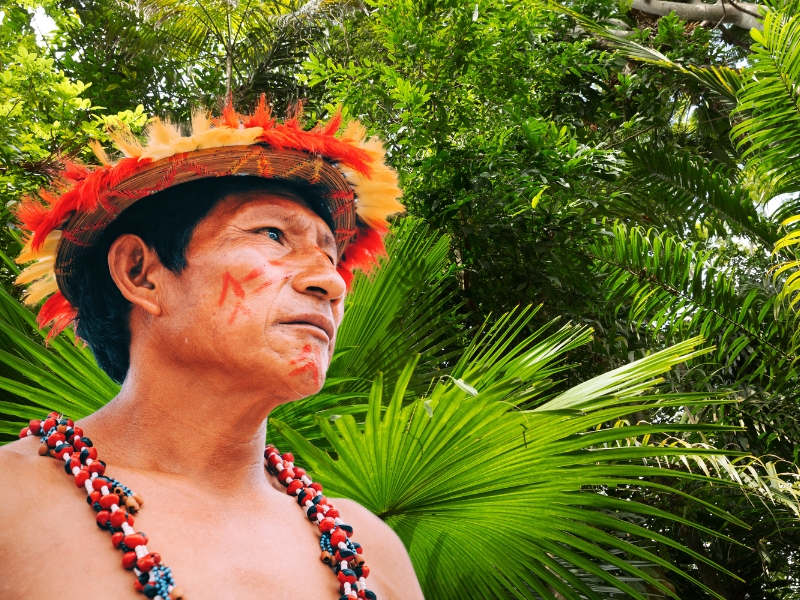
In Peru, 13 Amazonian Linguistic Families have been counted, which group 51 ethnic groups, which in turn are distributed in 1,786 indigenous communities with a total population of 332,795 inhabitants, which is equivalent to 1.2 percent of the total population of the country. The Loreto region is home to 11 of these Linguistic Families (84.6 percent), 29 of the ethnic groups (57 percent) and 705 of the Amazonian indigenous communities (39.5 percent), with a population of 105,900 inhabitants, representing 11.9 percent of the population of the region.
The Amazonian indigenous communities of the Loreto region have a greater presence in the provinces of Maynas and Datem del Marañón, constituting 47 percent of the total population, while the province of Mariscal Ramón Castilla only has 8 percent of Amazonian indigenous presence. Loreto is home to all of the Huitoto, Peba-Yagua, Tucano and Zaparo linguistic families.
The indigenous population of Loreto is predominantly young, since almost half is under 15 years of age, a figure higher than that observed at the national level (30.5 percent). From 45 years of age, the proportion of the population falls to 9 percent versus 13 percent in the region and 15 percent in the country. Similarly, the population over 65 years of age is significantly lower in the indigenous population. It is expected that, as the census instruments are refined, it will be possible to determine whether this distribution of the indigenous population is due to a lower life expectancy (currently there are ethnic groups that are in danger of extinction) or to a process of migration to the cities.
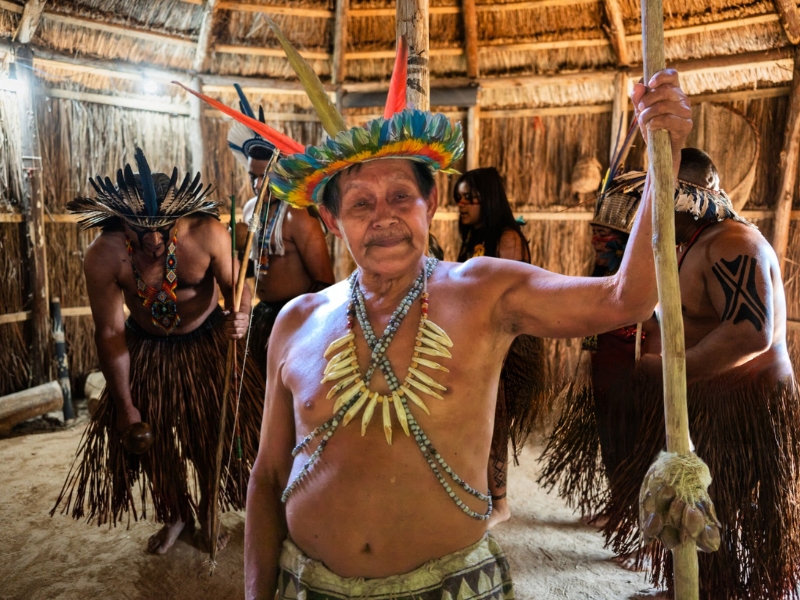
The Bora people live mainly in the north-eastern part of the department of Loreto, near the border with Colombia. The Bora are characterized by body painting, and the Bora are one of the peoples with the largest number of body drawings in the Amazon.
The Bora are traditionally divided into clans, each of which is led by a curaca. The Bora live in large communal houses. The Bora produce crops such as bananas, yucca, pineapple and other fruits for both consumption and sale. They also engage in fishing and hunting, and produce handicrafts which are sold to tourists who visit their communities.
The Bora are known, among other things, for their use of a communication system that was used to transmit messages over long distances between large multi-family houses. To do this, they used the manguaré, a communication instrument based on two mahogany drums and mallets, with which they emit sounds with tones similar to those of the Bora language.
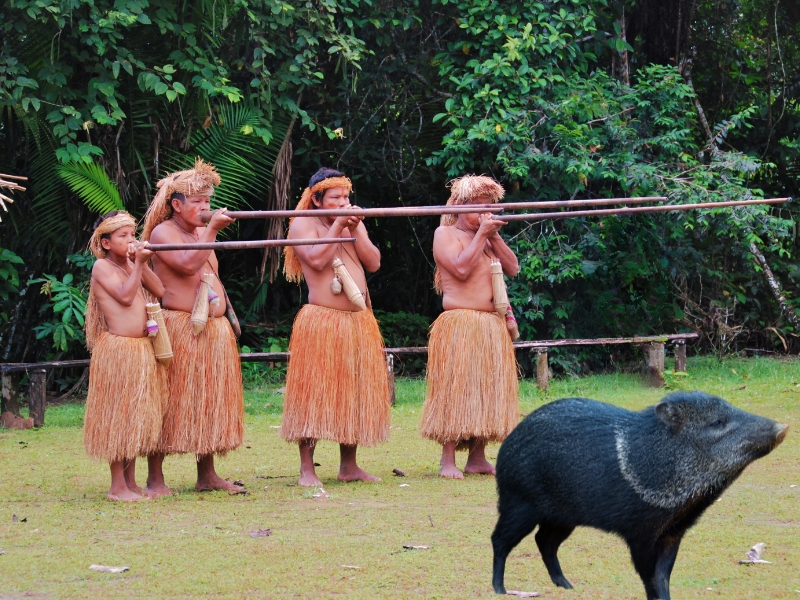
The Yagua people live mainly in the department of Loreto, in the border area with Colombia and Brazil. The Yagua are the only indigenous people whose language belongs to the Peba-Yagua linguistic family. The traditional clothing of the Yaguas consists of a breastplate, anklets and wristbands made of palm leaves, a red cloth skirt for women and a skirt called champa for men, made of palm leaves.
Currently, the Yagua communities, located near the city and linked to the tourist market of Iquitos, participate in this activity through the representation of their traditional customs, such as dance, music, crafts and the use of the blowgun. The Yaguas have a very complex worldview that is reflected in their animistic myths.
The Yagua consider water as their totemic element, as it is considered the source of life. The importance of this element is reflected in the birth ritual, where the mother gives birth kneeling on a bed of leaves near the watercourse. Likewise, the bathing of the Yagua men in the river was considered a strategy to ensure that the hunting animals would not become depleted.
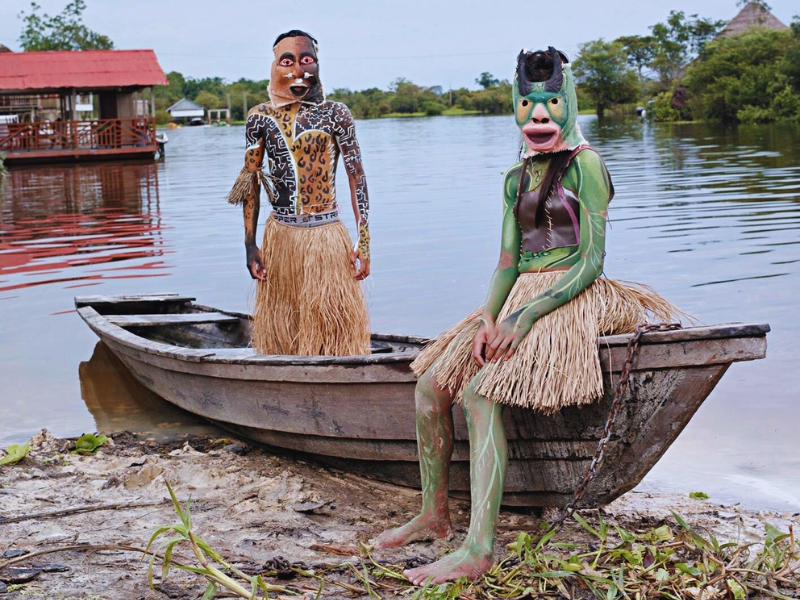
The Kukama Kukamiria people live mainly in the department of Loreto. According to the results of the 2017 national census, 10,762 people have identified themselves as part of the Kukama Kukamiria people due to their customs and their ancestors. Due to their long-standing interrelation with a floodplain ecosystem and their great adaptation to it, the Kukama Kukamiria have developed different instruments and techniques for fishing, which today are a heritage inherited from their ancestors.
The Kukama Kukamiria people, along with other peoples whose languages belong to the Tupí-Guaraní linguistic family, began a series of migrations from the Central Amazon in Brazil between the 9th and 16th centuries. They probably reached the areas they occupy today in Peru 200 or 300 years before the Spanish arrived.
The basis of the traditional organization of the Kukama Kukamiria are the paternal kinship groups, called “bloods” and associated with totems or founders. Within these groups, surnames are transmitted that correspond to the names of plants and animals. According to this kinship organization, marriages constitute exchanges between two “bloods.”
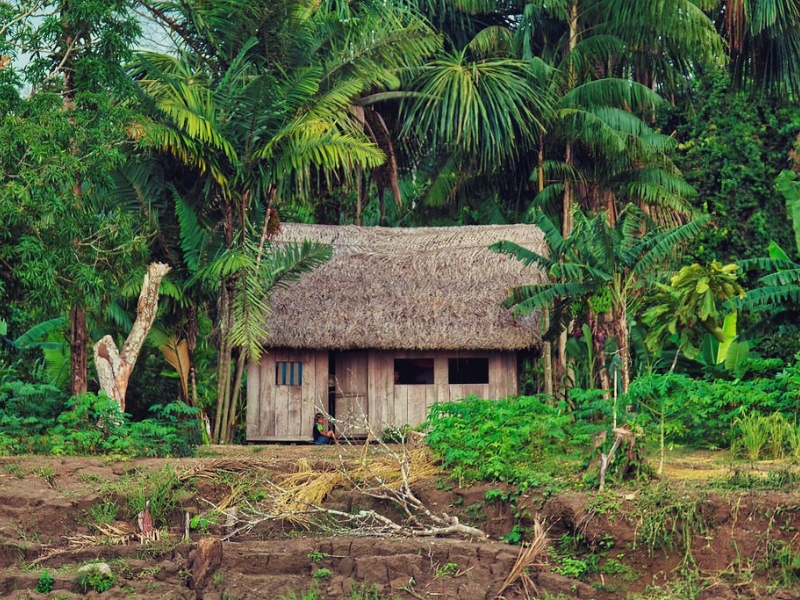
The Ikitu people live mainly in the province of Maynas, department of Loreto. Like the Arabela and Vacacocha peoples, the language of the Ikitu people belongs to the Záparo linguistic family. During the 17th and 18th centuries, many Ikitu were forced to join missions of the Jesuit Order. In general, contact with foreign agents affected them physically, causing epidemics that significantly decimated this people.
One of the main traditional subsistence activities for the Ikitu is agriculture, with their main agricultural products being yuca, plantain, sweet potato, corn, sachapapa, tobacco, cotton and barbasco. They have maintained that their traditional tools for fishing and hunting are the harpoon and the arrow, as well as the spear and the blowgun, respectively.
The Ikitu live in communities, where mainly the older adults preserve the use of their own language. However, as a result of the loss of the native language, a significant process of interbreeding is observed among the younger generations. The same is true for marriages, as many of them marry indigenous people from other ethnic groups such as Shiwilu, Achuar and Shawi.
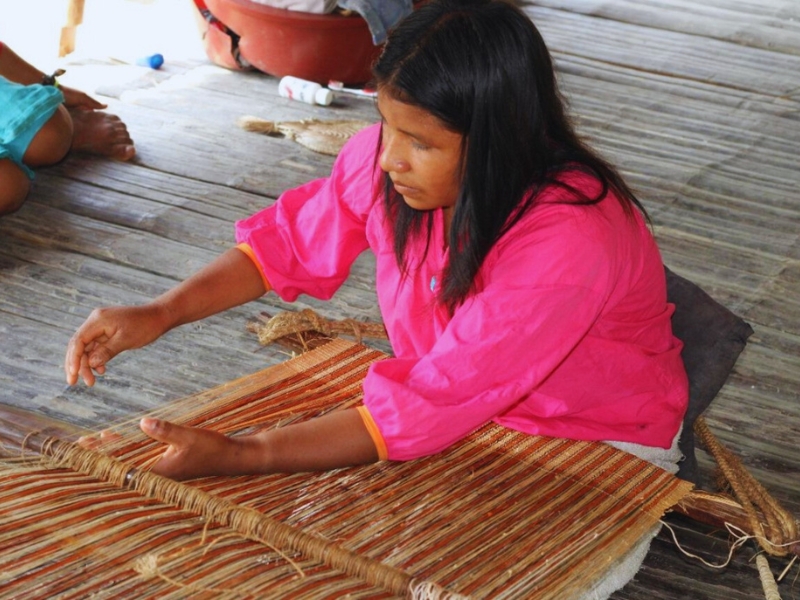
The Urarina people live mainly in the department of Loreto. The Urarina people identify themselves under the term kacha edze, which means ‘people’. The Urarina people are dedicated to agriculture, hunting and fishing, which are the main economic activities. In relation to hunting, traditionally, the Urarina would practice it individually, using tools produced by themselves, such as the blowgun or pucuna.
The Urarina have among their main crops corn, cassava, peanuts, sweet potatoes, squash, cocona and tobacco, the Urarina are also dedicated to the commercialization of dried meat from wild animals, bananas, chickens, wood, rice and fish through mestizo merchants.
The Urarina language is the only language of the Shimaco linguistic family, so it is considered an isolated language. It has also received the names Itucali, Kacha Edze and Itukale. It is spoken by the indigenous people of the same name in riverside communities of the Tigrillo, Patayacu, Chambira and Corrientes rivers, in the department of Loreto.
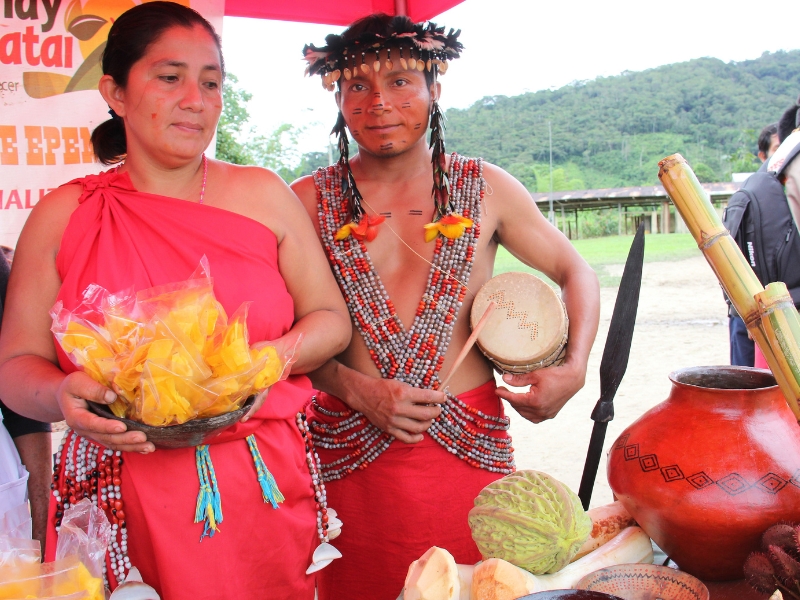
The Awajun people, also known as Aguaruna, represent the second largest indigenous or native Amazonian population in Peru. In the Awajun world there are masculine activities (war, hunting, fishing, making tools, baskets and weaving, building houses, among others) and feminine activities (raising children, animals and plants, and making pottery, among others). This separation is reflected in their religious symbolism, which is characterized by the separation of feminine spirits and masculine spirits.
The masato plays an important role in Awajun social life. One of the most well-known ceremonies of the Awajun people is the preparation of the tsántsa (shrunken heads). Traditional Awajun clothing is made of cotton, grown and woven on rustic looms, and is made by men. Male clothing is based on a skirt, or itipak, fastened at the waist by a belt. Women wore a one-piece dress, buchák or taráchi, which was tied over one shoulder with a rope.
Both men and women wore their hair long with bangs over their forehead. On special occasions, men wore their hair braided. Tattoos and face painting with achiote and huito are very common. Men’s and women’s adornments are made from toucan feathers, beetle wings, and a wide variety of seeds.
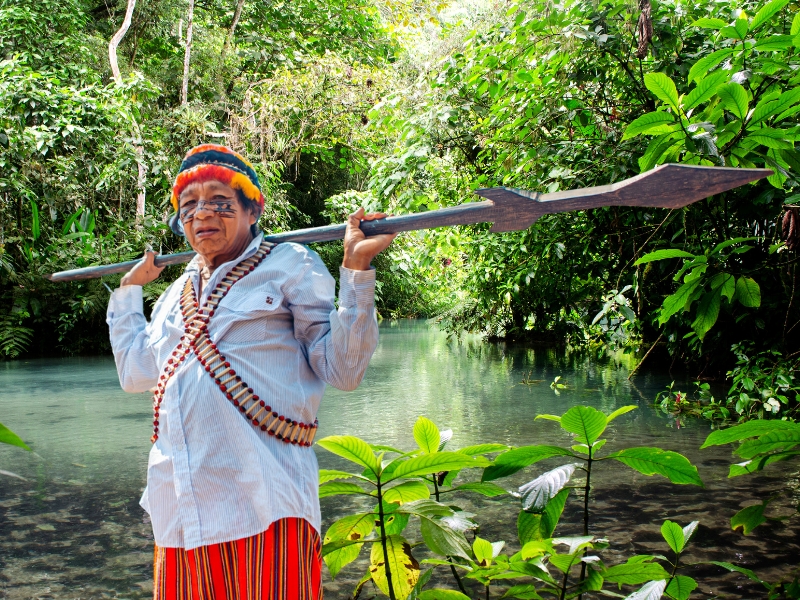
The name of the Achuar people comes from the name of the large palm trees found in the area of the Peruvian Amazon that they have ancestrally occupied. Their language belongs to the Jíbaro linguistic family. The Achuar people live mainly in the north of the department of Loreto, near the border with Ecuador. The composition of the Achuar households, as well as the type of settlement in the territory, is diverse. While some Achuar live in communities where the houses are isolated, others live in densely packed native communities.
The men are dedicated to hunting and fishing, the women are more related to agricultural activity. It is traditional for each Achuar woman to own and manage her own farm where they produce (cassava, plantain, fruit, barbasco, corn, beans, peanuts).
A widespread Achuar custom is the daily consumption of an infusion of Wayusa leaves. This plant is considered a natural and spiritual medicine, being used for healing purposes.
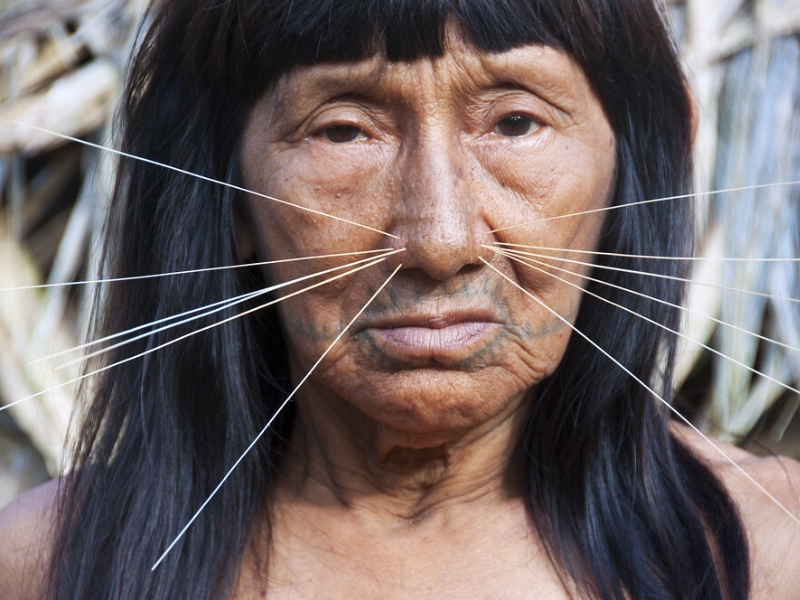
The Matsés people live mainly in the province of Requena in the department of Loreto, in the Brazilian border area. The Matsés have been considered the northernmost representatives of the Pano group, made up of people whose language is part of the Pano linguistic family.
In ancient times, the Matsés lived in extended families, each with a leader, and settled in large houses or malocas. These families had reasons for constantly changing their area of residence: the scarcity of game animals, the need to make a new farm, the death of an important member of the family or threats from other indigenous groups or foreigners in their usual areas residence.
Traditionally, the main farms used to provide the Matsés with daily food consumption were located on the outskirts of the houses. The secondary farms were scattered at various strategic points to facilitate movement through the forest. Hunting has been an important male activity among the Matsés. Adult men often pass on their knowledge and other teachings related to this activity to young Matsés. Today, the Matsés mainly use shotguns for hunting, as well as flashlights and canoes with motors, which have allowed them to hunt at night and in a larger area.
The Anaconda Handicraft Market is one of the most popular destinations for visitors arriving in the city of Iquitos in the Amazon region of Peru. This market is known for offering a wide variety of local handicrafts, including products handmade by artisans from the region. It is located in the city of Iquitos in the Amazon region of Peru.
The market not only serves as a place to buy and sell handicrafts, but also as a cultural meeting center where visitors can immerse themselves in the vibrant atmosphere of the city of Iquitos and learn more about life and crafts in the Amazon region. Over the years, the Anaconda Handicraft Market has contributed to the livelihood of numerous local artisans and has helped preserve and promote the cultural traditions of the Peruvian Amazon.
At the Anaconda Artisanal Market in Iquitos, Wooden crafts: Hand-carved sculptures, jungle animal carvings, ritual masks, and other decorative objects made by local artisans. Jewelry: Jewelry made with jungle seeds, such as acai, tagua, or huayruro seeds, as well as necklaces, bracelets, and earrings inspired by Amazonian nature.
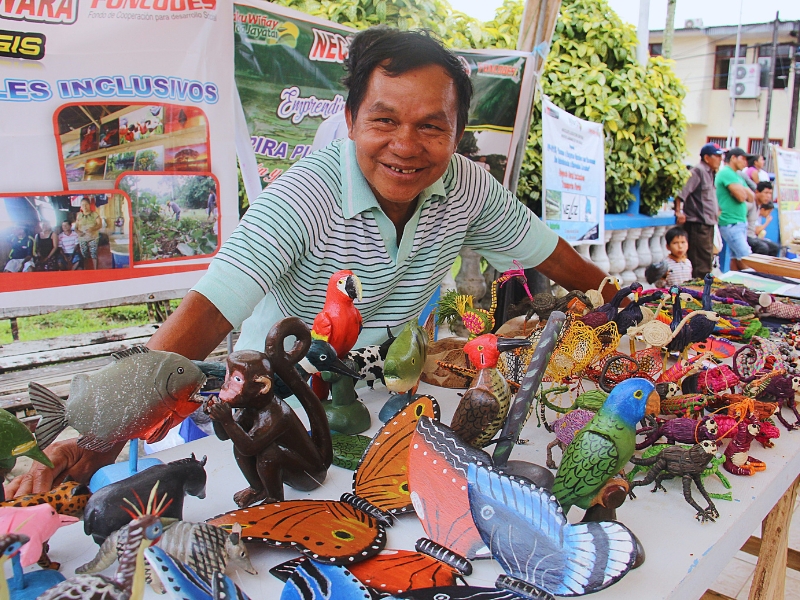
Textiles: Traditional handmade textiles, such as blankets, hammocks, scarves, and bags, with colorful designs and motifs inspired by the flora and fauna of the jungle. Ceramics: Handcrafted ceramic pieces, such as vases, jars, and figurines, decorated with geometric designs or inspired by the indigenous iconography of the region.
Musical instruments: Traditional Amazonian instruments, such as bamboo flutes, maracas, drums, and other percussion instruments, handmade by local artisans.
Souvenirs and souvenirs: A variety of small items and souvenirs, such as magnets, key chains, t-shirts and other items with motifs related to the Amazon rainforest and Peruvian culture.
In addition to the wide selection of products available for sale, the market also offers a unique cultural experience, where you can interact with local artisans, learn about their manufacturing techniques and learn more about life and culture in the Peruvian Amazon.
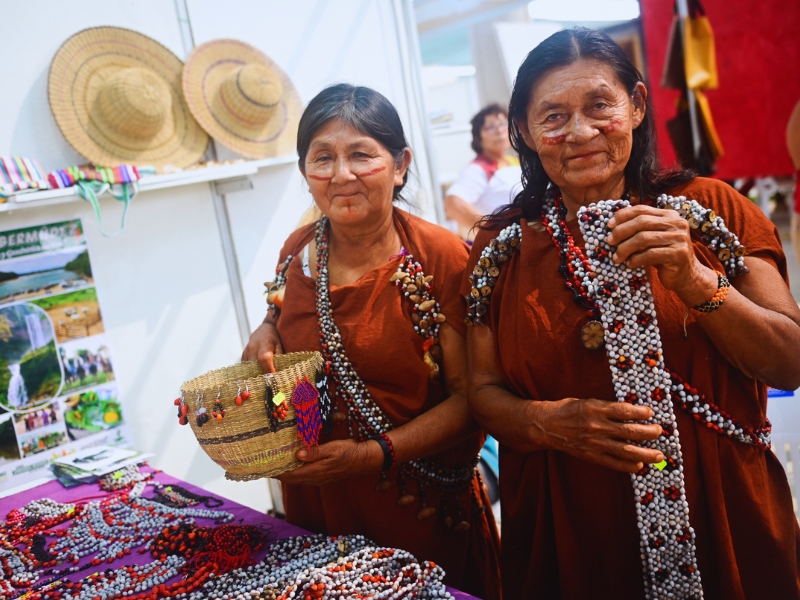
A very attractive place to explore and shop for crafts and souvenirs from your visit to Iquitos is the emblematic Belen market. Entering the market and getting lost in the muddy streets crowded with people and stalls creates a unique sensory impact. The colors, the noise, the voices of the vendors offering products, the smells and the humidity mix together to form a dense atmosphere, somewhere between attractive and unbreathable.
Perhaps the most attractive thing about this Amazon region is the body adornment crafts that consist of making necklaces, bracelets and skin decorations, using seeds, paiche scales, feline and monkey fangs, vegetable dyes and colored earth. Artificial flowers are also made from the gramalote that abounds on the banks of the rivers; although this technique has been gradually lost.
Basketry is very varied due to the large number of palm trees that exist in the Amazon forest; Baskets, bags, cages, sieves, hammocks and hats are made from these. Various ornaments are made from the topa lama, representing species of fauna. In the city of Iquitos, the wood is used to make highly appreciated decorative objects.
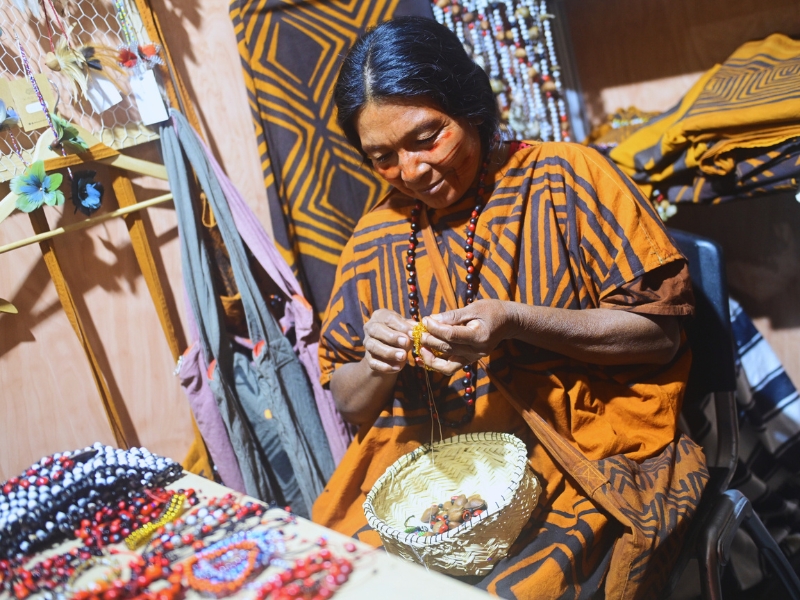
The San Juan Handicraft Market is located 4.5 kilometers from Quiñones Avenue, specifically on the highway to the airport in the city of Iquitos, in the district of San Juan Bautista. This market produces and sells a wide variety of handicrafts from the Amazon rainforest in Iquitos, typical of the region, since they are made by the inhabitants of the native communities. These products are: woven from plant fibers, carved wood, ceramics with typical motifs, paintings on tree scraps, embossed leather crafts and typical drinks, among others.
Unlike other markets, the San Juan Handicraft Market is the place with the greatest variety of handicrafts, carvings, necklaces, bracelets, ornaments, textiles and paintings made with materials from the area from the products that nature has to offer. Because the San Juan Handicraft Market has an environment for exhibitions of Amazonian culture, you can see countless wooden and fabric items on art displays.
Traditional medicine, one of the most important expressions of the ancestral memory of the Amazonian peoples, makes use, among other practices, of a large number of plant species to cure their illnesses and syndromes. The Peruvian Amazonian flora constitutes one of the largest reserves of phytotherapeutic resources.
Since those distant years to the present day, numerous species have been studied, obtaining from them important biologically active compounds that have contributed to alleviating the ailments of humanity. Among the latter are the “sangre de grado” (Croton lechleri) and the “uña de gato” (Uncaria tomentosa), (U. guianensis). Knowledge of the medicinal properties of plants is based on observation, experience and deep knowledge of the environment. Transmitted from generation to generation and enriched by the cultural integration of the native and migrant population, this knowledge has become popular medicine and current herbalism. This knowledge, duly systematized, contributes to solving, in part, the health problems of the less favored population and the most distant from modernity, whose possibilities of being cured are, at present, limited by the high cost of modern drugs.
A paradoxical situation if one considers that in many cases the pharmaceutical industry is based on the basic knowledge that different human groups, unjustly branded as primitive, have developed over generations on the healing properties of plants. Among them, there are numerous Amazonian ethnic groups. For a good use of medicinal plants, it is necessary to know correctly the species used, the form of preparation and dosage, as well as the care that must be observed. Many of the compounds present in plants act synergistically, so that the combination of two or more species is a necessary condition to obtain beneficial effects. In this context, the link between traditional medicine and scientific medicine through ethnobotanical research, the study of active principles and the validation of the therapeutic activity of plants, allows for the availability of natural regional resources for the treatment of diseases that commonly affect the population.
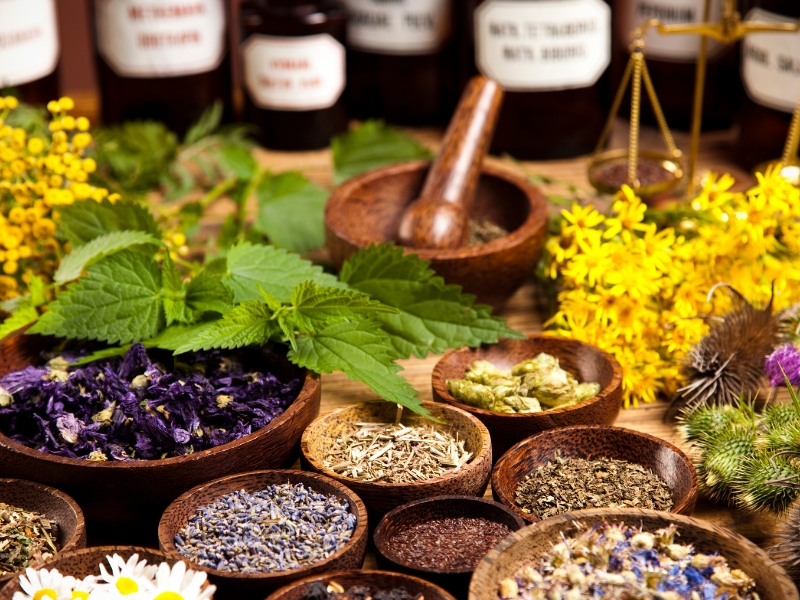
The largest number of species are used for the treatment of ailments, respiratory problems, psychosomatic and nervous problems, kidney and urinary tract diseases, rheumatism and arthritis. Treatments are most often performed in the homes of individual healers, who typically have their mesas (portable healing altars) set up in their yards.
Healers also treat patients in front of altars in the consultation chambers in their homes, at sacred sites in the countryside or at sacred lagoons. Healing altars carrying a large number of power objects (artes) are most frequently employed. A healing ceremony typically involves purification of the patient by orally blowing blessed herbal extracts all over the body to defend it from evil spirits in addition to nasal ingestion of tobacco juice and perfumes.

Bad Air, Bad Wind, Susto or Espanto, Mal de Ojo and Damage or Witchcraft are perceived as very common illnesses in Andean society. Causes include sudden changes in body temperature (Mal Aire, Mal Viento), any type of shock (Susto, Espanto), negative moods emitted by certain people (Mal Ojo) and poisoned food, curses, etc. Treatment in many cases involves the patient’s participation in a cleansing ceremony or “limpia.” This could be a relatively simple treatment with perfumes and holy water or an all-night ceremony (mesada) focused on the altar (mesa) of the healer.
After the ceremony the patient is usually treated with a “spiritual blossoming bath” in order to rid him or her of any remaining symptoms or “spirits.” In addition, the patient is often given a “safe” or herbal amulet for protection against future bad influences and for good luck. Sure are jars or bottles filled with magical herbs, as well as perfumes, images of saints, and the patient’s hair and nails. The huge number of plant species used for the treatment of psychosomatic disorders indicates that healers in northern Peru are valued as specialists.
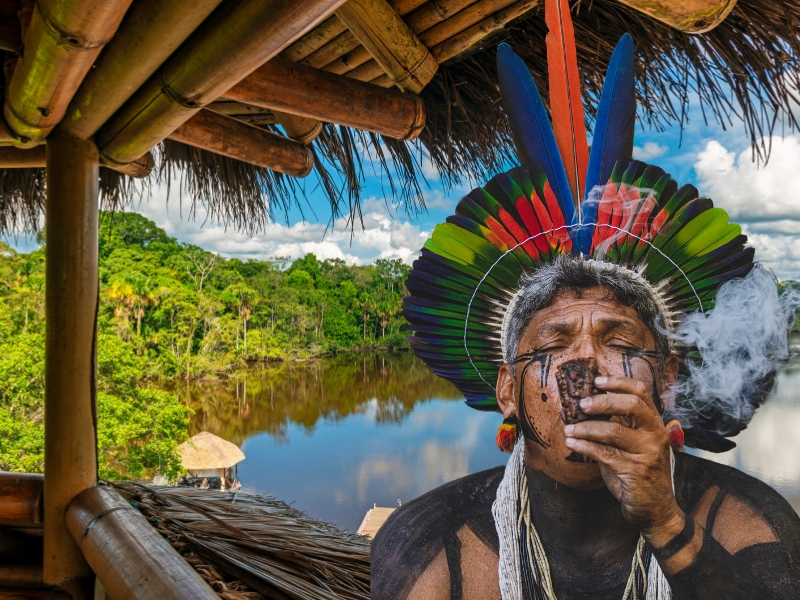
Healers in northern Peru prefer to use the leaves (in 25% of all uses) or the whole plant (24%) for the preparation of their remedies. In 19% of cases the stems of the plants are used, most commonly together with the leaves. Flowers (10%), seeds (7%), fruits and roots (4% each), bark (3%), fruit peel (2%) and latex and wood (1% each) are used for a small number of the recipes. Almost 64% of the remedies used in northern Peru are prepared using fresh plant material. Many of the introduced species are cultivated in fields and gardens, but most of the indigenous species are collected from the wild. This indicates that a widespread system of plant collectors is needed to supply the fresh plant material needed for Traditional Medicine.
Many traditional healers use herbal preparations – often consisting of complex ingredients and very specific preparations – to treat their patients’ illnesses, rather than just using extracts from individual plants. However, studies documenting these preparations and analyzing the composition of the mixtures are almost non-existent.
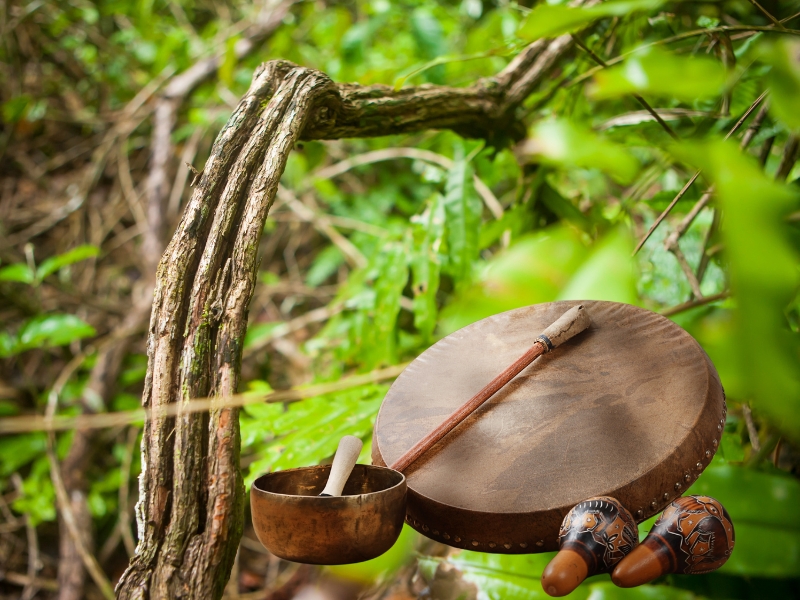
Ayahuasca is a plant used in ancestral medicine and is currently in vogue among people seeking to improve some aspects of their health or who wish to experiment for recreational purposes. In Peru, the practice of ritual sessions of ayahuasca has been recognized as a fundamental pillar of the identity of the Amazonian peoples, and the knowledge and traditional uses of ayahuasca practiced by native communities have been declared Cultural Heritage of the Nation since 2008.
Ayahuasca (Banisteriopsis caapi) is considered a wise or master plant and acts in conjunction with chacruna (Psychhotria viridis). It is a concoction prepared by cooking these two plants and, depending on some ethnic groups or places, other plants may be added. This entire process takes place in the midst of a ritual that involves advance preparation by the guide, teacher or shaman and the participant. There is archaeological evidence of the use of ayahuasca in ceramics and designs dating back approximately two thousand years BC.
Every June 24th, the Feast of San Juan is celebrated, where homage is paid to San Juan Bautista. This is, without a doubt, the most important celebration of the city and of the entire Peruvian Amazon. The city pays homage to San Juan Bautista, patron saint of the department of Loreto. It is said that the saint is especially venerated because he baptized people in the Jordan River, and Iquitos is surrounded by three rivers: Amazonas, Itaya and Nanay. The celebration usually includes large parties in which local cuisine is enjoyed, especially the traditional juane, whose name was inspired by the saint.
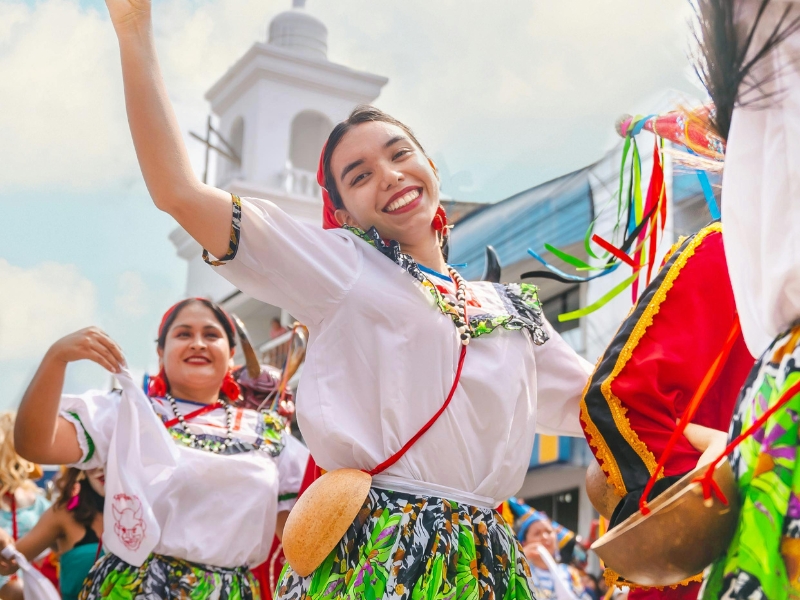
To talk about this festival we must go back to colonial times, when a group of missionaries named San Juan Bautista as the patron saint of the Peruvian Amazon, in commemoration of his birth. And since this biblical character was responsible for the baptism of Jesus in the Jordan River, there is still a very strong connection between the festival and water, which is why it is celebrated in fountains, rivers and lagoons.
In ancient times, on the eve of this celebration, residents of the surrounding areas would approach the rivers to purify themselves and receive the blessing of the prophet. In addition, in the early years, the religious ceremony was accompanied by meetings characterized by the warmth and joy of the jungle, where music and dance were present. Later, in the 20th century, this festival became official and is now celebrated in different destinations in the jungle, through cultural expressions very typical of each place, such as gastronomy, dance, crafts, stories and faith.
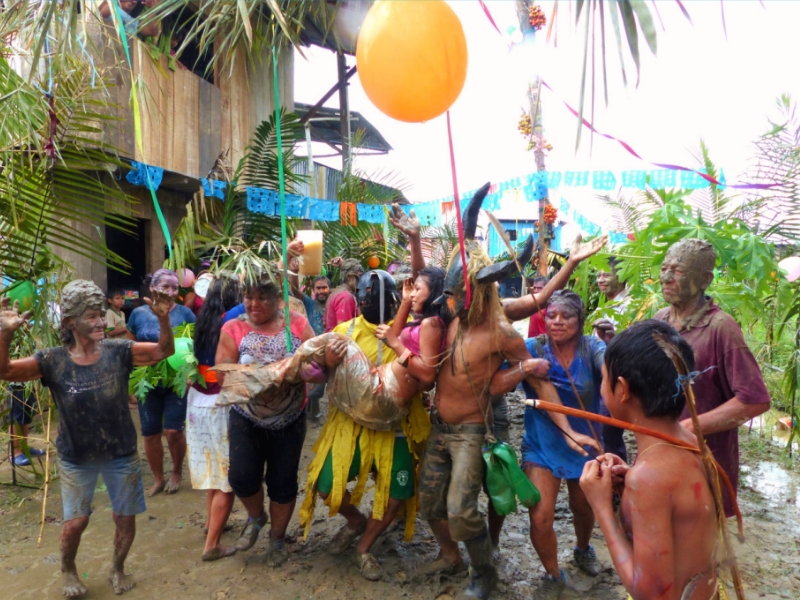
One of the most important events in the city of Iquitos is the colorful celebration of the Amazon Carnival, a festival that brings together locals and tourists in an outpouring of joy and tradition. Between the months of February and March, the city is filled with joy, celebration, floats, dances and all kinds of activities, in which all the neighbors participate. According to tradition, this is the time when the spirits of the jungle come out to have fun and the people join in the celebration. Typical dishes such as dorado ceviche, inchicapi, timbuche, patarashca and tacacho are the favorites during this festivity. The parades are also very striking, with typical clothing and regional music.
In addition to the parade, the carnival has costume contests, dance competitions and live music, where cumbia and salsa are mixed with native rhythms such as festejo and saya. You can also enjoy delicious typical food and refreshing drinks, such as the famous “juane” and “chicha de jora.”
The costumes are made with used clothes, scraps of cloth, sacks of rice or beans, among other ingredients; while the masks are allusive to animals of the region or grotesque male or female faces. Traditionally, these are made with huingo seed (Crescentia cujete), topa wood and cardboard decorated with small branches and drawings made with natural pigments, which are made with drawings and/or small branches and natural dyes.
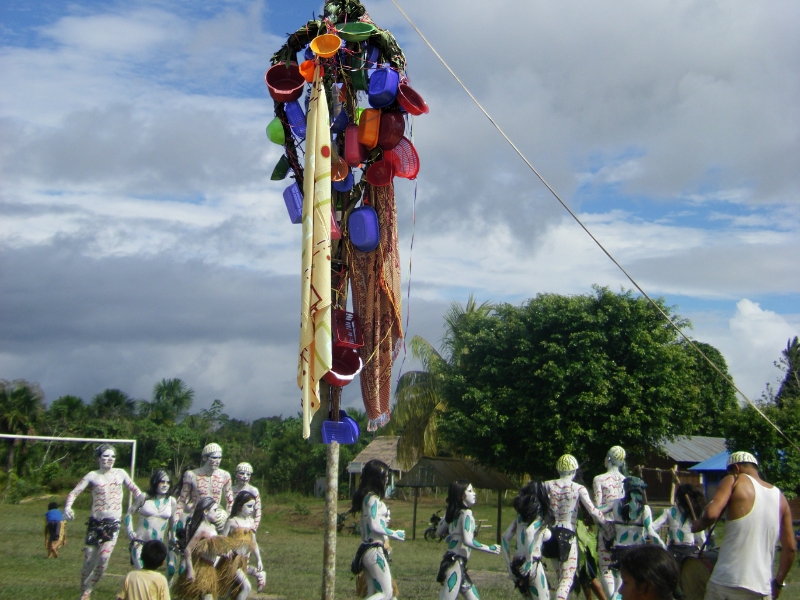
Different neighborhoods in the city organize to decorate the humisha, a palm tree that is filled with gifts, ribbons and balloons. At the end of the celebration, the neighbors dance around the tree and take turns cutting it down with an axe or machete. Whoever cuts it down will be in charge of decorating it the following year. The participants, dressed in colorful costumes and masks, perform choreographies that fuse indigenous and colonial elements, creating a unique representation of the cultural identity of Iquitos.
This dance is accompanied by the vibrant rhythm of drums and maracas, along with the energetic movements of the dancers, who dance around a sacred tree called “Yacumama.” The energy that emanates from the dance infects the spectators, inviting them to join in and celebrate the diversity and cultural unity of the region.
The Humisha Dance not only entertains and delights those who witness it, but also transmits values of cooperation, respect and brotherhood. It is a way to keep the history and customs of Iquitos alive, promoting the pride of belonging to this city rich in traditions and natural beauty.
The typical dances of Iquitos jungle are mostly characterized by warrior dances or local rituals. These dances are performed by different ethnic and non-ethnic groups both inside and outside Peru. The dances of Iquitos are a vibrant and colorful cultural manifestation that reflects the rich ethnic and natural diversity of this region. These dances are a fusion of ancestral indigenous traditions with colonial and mestizo influences, creating a unique and authentic expression of the Peruvian Amazonian identity.
The dances of Iquitos have their roots in the ancient indigenous cultures that inhabited this region before the arrival of the Spanish conquistadors. These cultures developed a wide range of rituals and ceremonies that involved dancing as a form of communication with the gods, nature and ancestors.
Over time, the dances of Iquitos have remained alive through generations, passed down from parents to children as a fundamental part of the region’s cultural identity. Today, these dances continue to be practiced and celebrated at festivals and cultural events throughout the Peruvian jungle, serving as a powerful connection to the past and a symbol of pride for local communities.
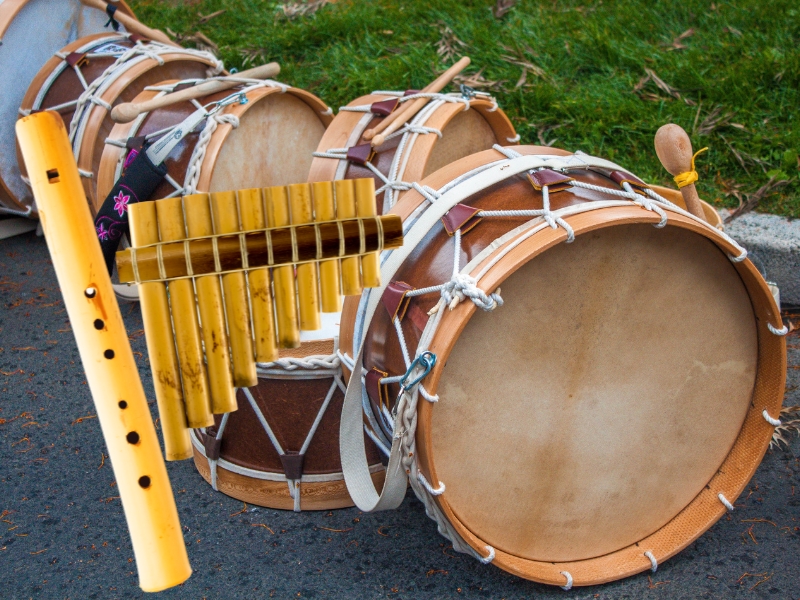
Peruvian jungle dances are characterized by their contagious energy, frenetic rhythm and colorful traditional costumes, but also by representing war, ceremonial and religious dances, each depending on the situation.
Music, which is usually performed live with native instruments such as drums, maracas and bamboo flutes, is an integral part of these dances, marking the beat and creating a festive and joyful atmosphere.
The movements of jungle dances often imitate animals from the region, such as snakes, birds and jaguars, as well as everyday activities such as hunting, fishing and farming. The dancers combine fast movements with energetic steps and acrobatic jumps, creating a dynamic and visually striking spectacle.
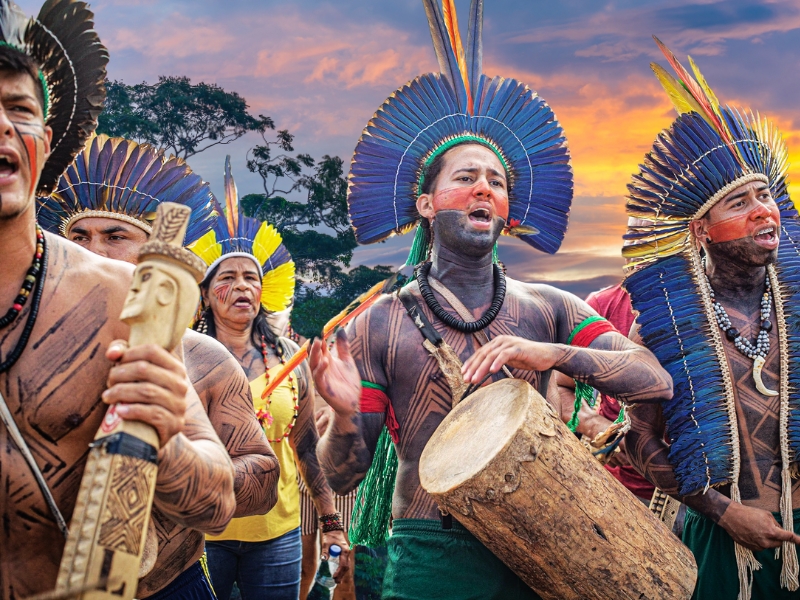
In the Ayahuasca jungle dance, the shaman or healer of the community makes a potion with palo de huasca and chacruna. This mixture is what gives the Ayahuasca dance its name. When this type of procedure is performed, the shaman or healer of the tribe accompanies the preparation with chants of worship to nature. This is done so that the ayahuasca is entrusted and has good effects for the patient. At the end of the dance, people make donations to the shaman, which are mostly animals.
The men dress in cotton clothes and use colorful blankets and some trusses. They use crowns made from llanchana, also belts and other accessories such as beads and the feathers of some birds. The Ayahuasca dance is inspired by the work of the healers or shamans of the Amazon. In the dance, it is shown how the healer seeks to alleviate various illnesses. The healers entrust themselves to mother earth and father river to carry out this work.
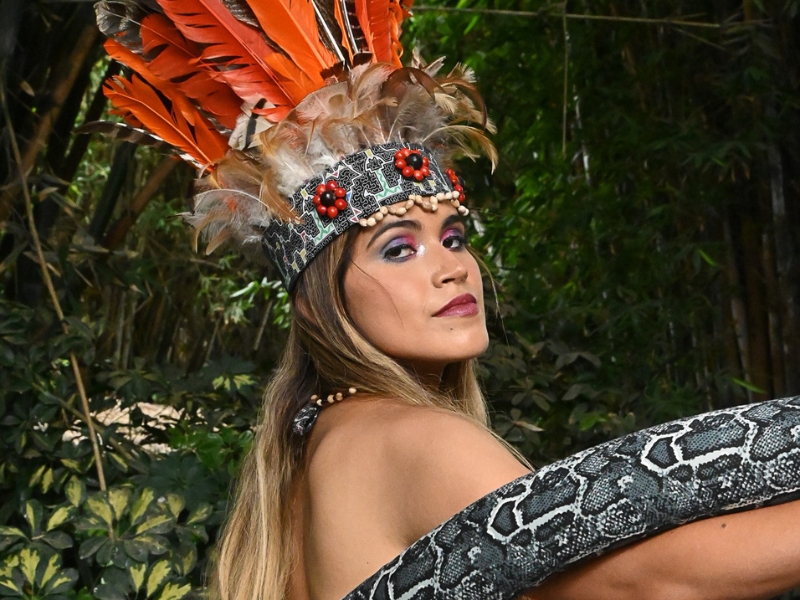
The Boa Dance is a typical dance from the Iquitos jungle. The main attraction is the enormous boa that one of the dancers carries. In this dance, like other jungle dances, the women wear very small clothes and when dancing they simulate the movements of the boa when it crawls. Most of the times that the Boa Dance is danced, it is done in parades for the anniversary of the cities.
In front there is always a girl who is in charge of holding the boa. All the people move from left to right, imitating the movement of the boa on the ground and making small jumps. Regardless of the event, or the number of participants in the dance, the movements are always the same.
In this dance, the women use crowns decorated with macaw feathers, jaguar skin and skulls of small monkeys. In addition, they wear a bra with a jaguar skin design and a small skirt of the same material. Men wear a more elongated crown on their heads, decorated with macaw feathers and small primate skulls. Necklaces made of seeds hang around their necks and short shorts hang around their waists.
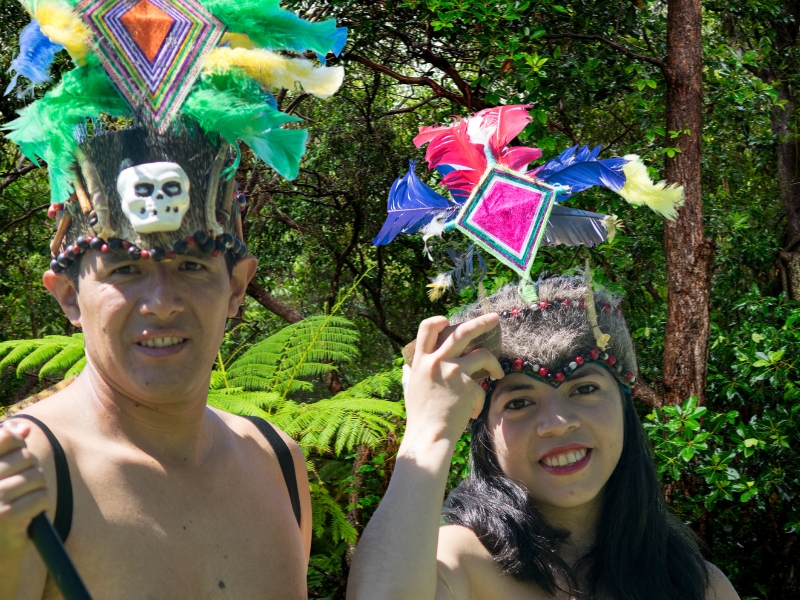
The Shipibo is a dance of mythical or magical-religious character and content. This dance acquires and transmits energy related to the bellicosity of tribes in the Peruvian Amazon. This is a dance of warrior origin. It is based on the dispute over territory between the Yawuas and Shipibos.
The cheerful element in the women’s clothing is the blouses. With intense colors and prominent edges, their fabric can be silk or cotton and they wear them at all times of the day. Women use necklaces and bracelets made by themselves and with seed materials.
More than half a century ago, men used to dress in “cushmas.” These are tunics that reach the ankle. This clothing was for daily use and they went to work with it, however, today it is only used in ceremonies or shamanic rituals and is a decorative piece, but not elementary.
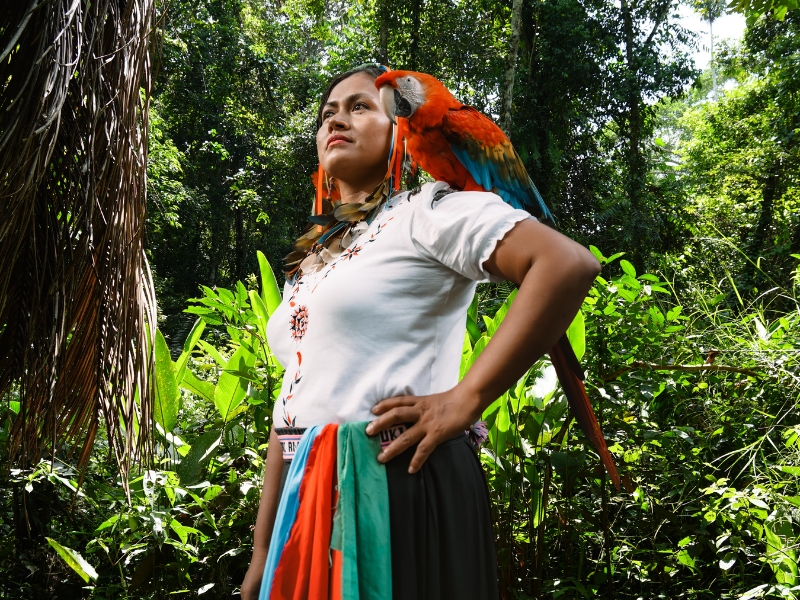
A dance that manifests its existence both in the mountains and in the jungle. The Pandilla is danced in the streets in comparsas, when the patron saint festivities of a town are celebrated or during carnival, it is very popular, because its performance is done externally in the main square of the town. The Pandilla is danced at the tomb of the Húmisha, in the month of February, the month of carnival. People advance, retreat, move to the rhythm of the music; they wave their handkerchiefs, shout; the bottles with liquor are shaken and when a good time passes, they spread it everywhere, bathing the dancers; others with their knees begin to hit the bottoms of the other couples, until they are left in pain.
Because of all these things that are manifested in the dances, it is said that the Gang is turbulent. It is a dance that constitutes a regional expression, since it is danced in all the provinces. It is joyful, mischievous and spontaneous; Their steps are characterized by jumps and other cheerful and contagious movements. Anyone can participate because of the ease of their movements.
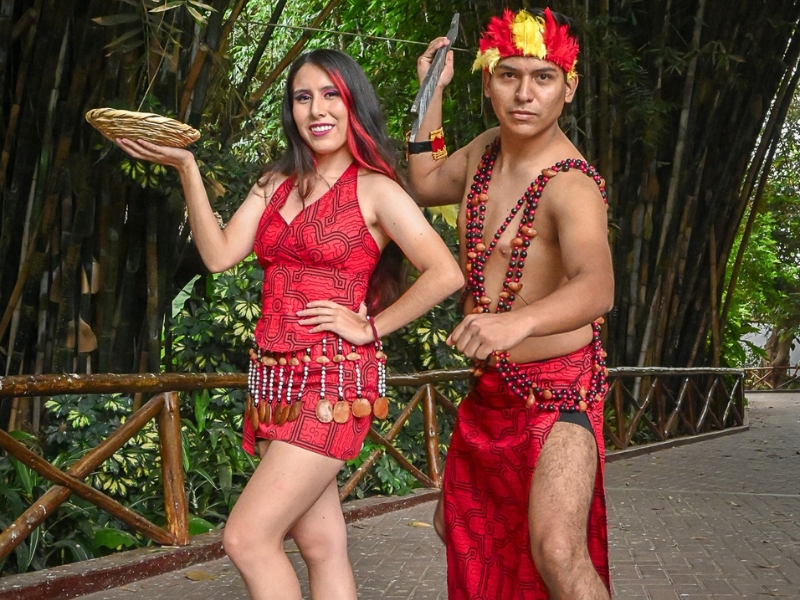
The Apu Cashi dance is a mix of Magic and Mystery of Jungle Folklore, based on the Literature of Tales and Legends of a range of Benign and Malignant beings, protagonists of incredible adventures where there is no lack of Healing and Witchcraft, combining the Musical Genre with Dances, Songs and Dances that express the joyful and melancholic style of the inhabitants of this region.
It is a joyful dance to pay homage to the bat god of the Shipiba indigenous community in the Pisqui River, where they pay homage to said god, for which he protects the community, thanks to the evil god for bringing a good harvest and fruit gathering. This festival is danced to the sound of Quenilla, Tambor, Bombo, Manguare and Maracas.
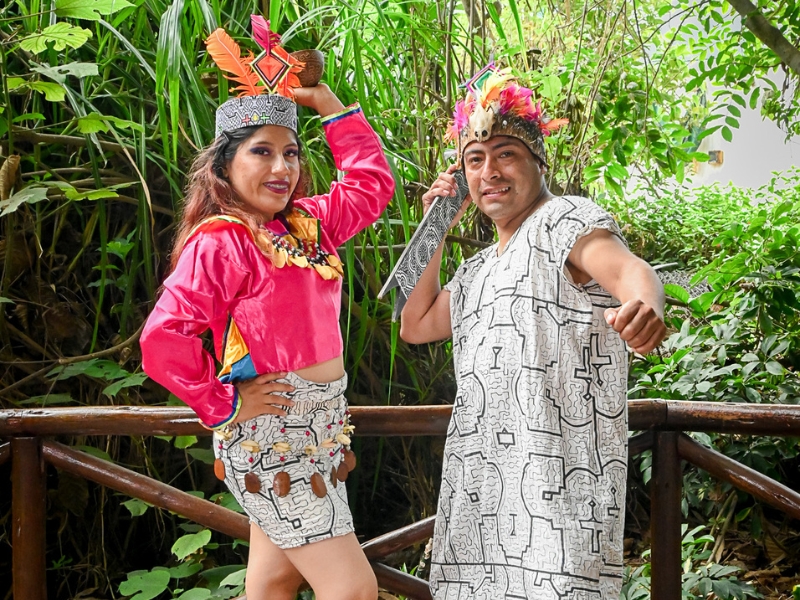
The Sitaracuy Dance is a cultural expression rooted in the Loreto region, whose Quechua name evokes the wild ants of the place. In this dance, couples immerse themselves in the rhythmic rhythm, emulating the attitude of the furious “Sitaracos.” The peculiarity lies in the pinches, which simulate the bites of these ants, and the dancers express the pain while moving to the beat.
This vigorous rhythm invites jumping and waving the hands, with movements that lean the body forward and backward simultaneously. The music marks the moment of the pinches, which can be given by any dancer on any part of the body, challenging the others to skillfully dodge them.
The characteristic attire for this dance preferably consists of two pieces: a flowery skirt and a blouse, without shoes or other accessories. The musicians, for their part, can move slowly around the ballroom, eventually occupying the centre of it, marking the beat with their melodies.
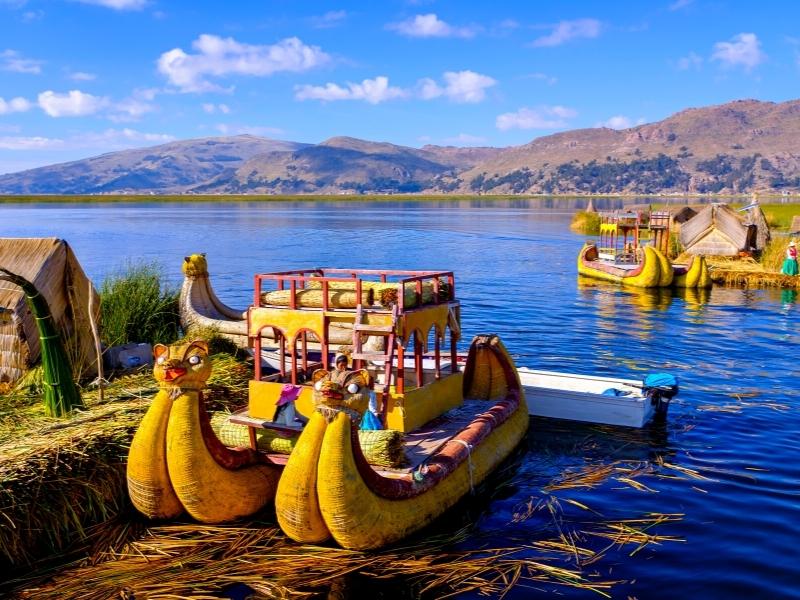
The wonders of Peru await you as you hike through the Manu Amazon rainforest, traverse the plains of the Sacred Valley of the Incas, and stroll the cobbled streets of Cusco on this 15-day trip from Lima. Search for monkeys and medicinal plants in the Amazon, travel the ancient road to Machu Picchu, experience a stay in a traditional community on the shores of serene Lake Titicaca.

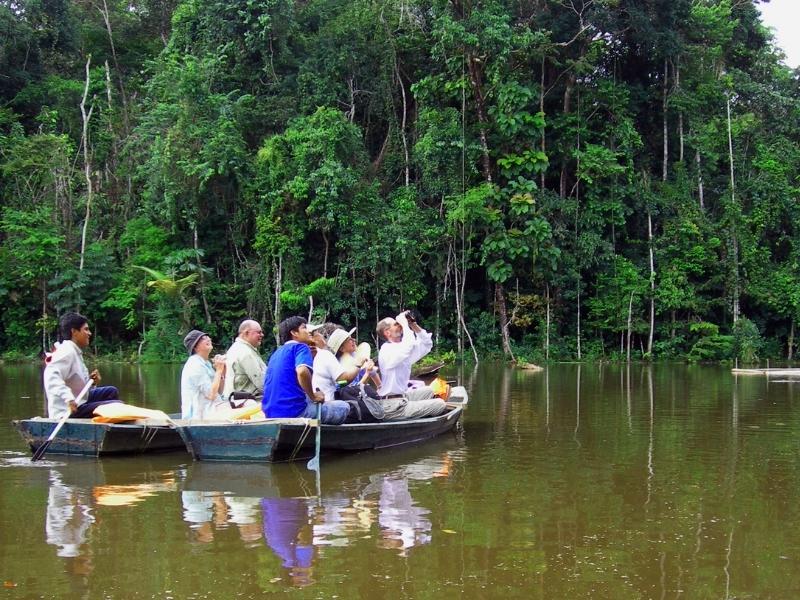
Your journey to the Tambopata National Reserve offers a great opportunity to discover a lively biodiversity of birds, mammals, reptiles, insects and trees. Record-setting numbers of animal species are concentrated within small areas, and the variety of plant life is greater than almost anywhere in the world.

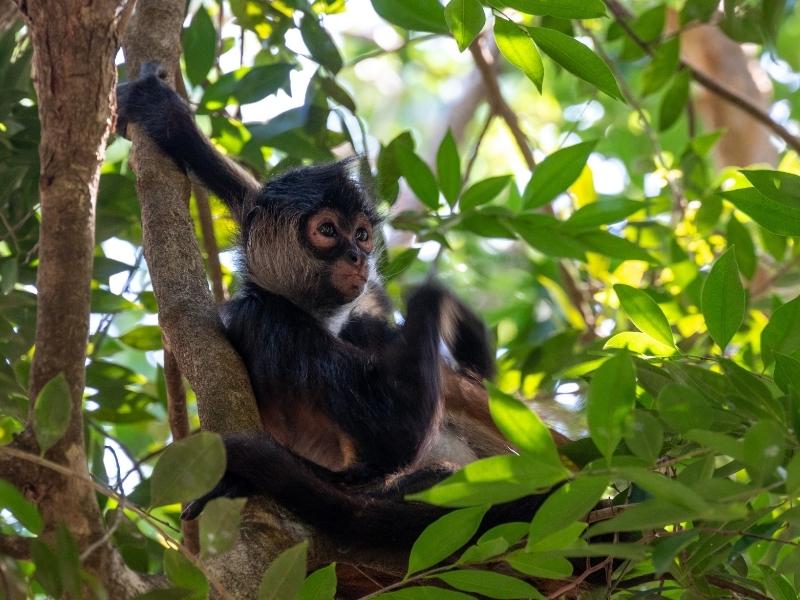
Manu National Park is an excellent way to experience an intense amazon wildlife.Is the biggest Amazon rainforest in the Americas, its incomparable natural wealth, host the greatest amount of flora and fauna of the world.

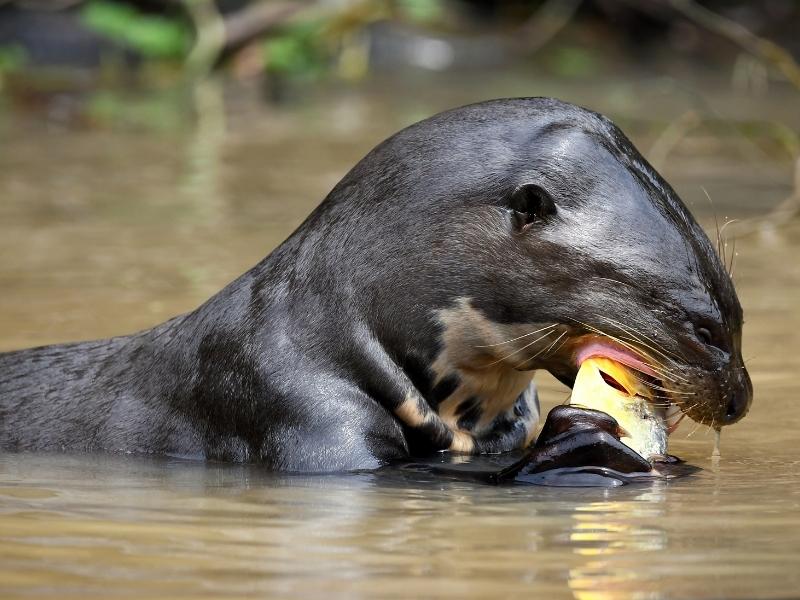
Discover the majestic Amazon rainforest of the Manu National Park. This protected area is in Peru, it is one of the largest ecosystems on the planet, due to its great diversity of birds, insects, plants and mammals.

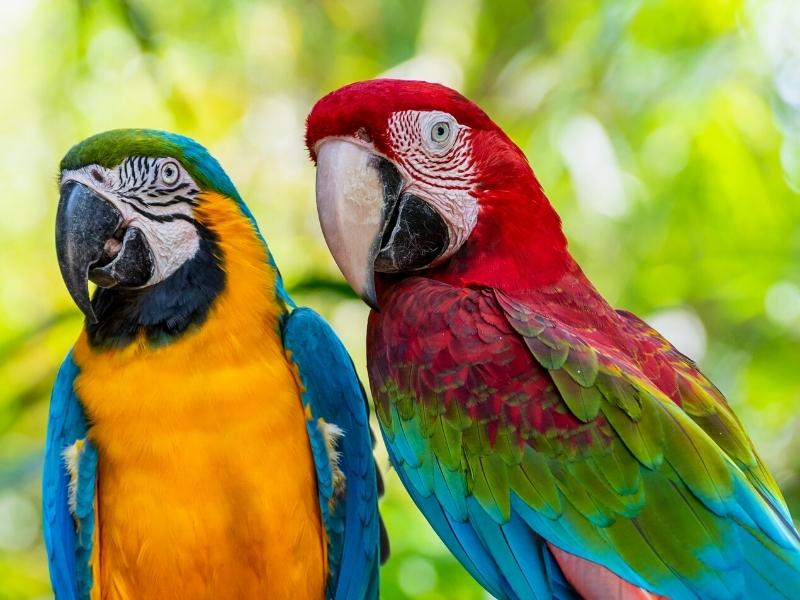
Visit the beautiful Amazon jungle of Tambopata in South America and enjoy the most impressive natural spectacle, we are referring to the blue and yellow macaw clay lick. Accompanied by the best local guides.

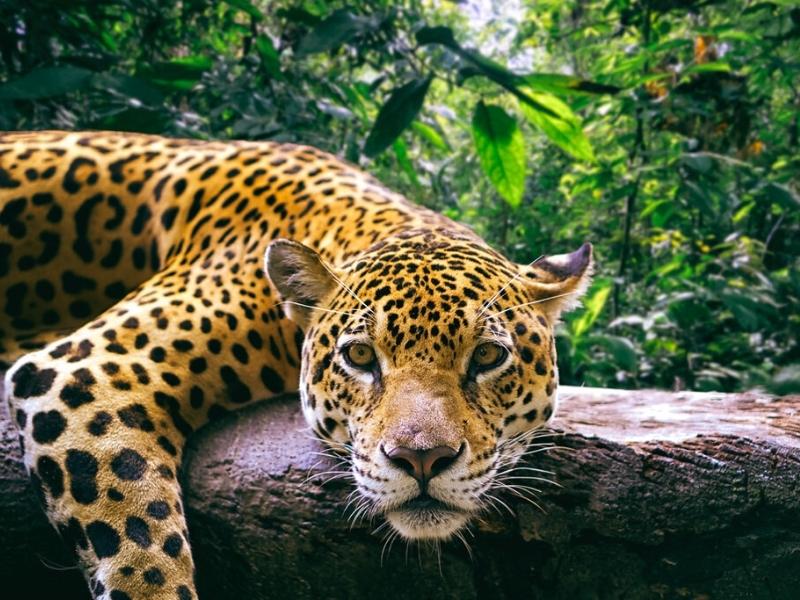
The Manu Jungle tour goes to one of the largest life biosphere reserves in the World. You will enjoy wildlife, traditional villages, with the best specialized guides.
